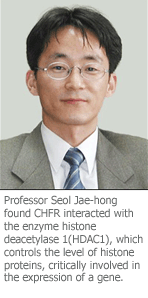 Professor Seol Jae-hong, Dept. of Biological Sciences?has found how the function of a gene, called CHFR, is linked to the development of human cancers, adding details to the complex picture of how tumors are caused and grow.
Professor Seol Jae-hong, Dept. of Biological Sciences?has found how the function of a gene, called CHFR, is linked to the development of human cancers, adding details to the complex picture of how tumors are caused and grow.
The new findings could eventually open new opportunities for drug development and provide insight into different types of cancer,?Professor Seol said.
CHFR, short for checkpoint with fork-head associated and ring finger, is a ``checkpoint protein'' known for its role in maintaining genetic stability and controlling cell proliferation.
Recent studies have identified CHFR as a tumor suppressor, as the expression of the gene is missing or low in different types of cancers.
A University of Michigan study last year revealed that CHFR expression is missing in more than one third of cases of breast cancer and is also frequently suppressed in colon and gastric cancers.
According to previous findings, the absence of the gene results in cells that are genetically unstable, which can drive mechanisms that accelerate the development of cancer.
However, there hasn't been a wealth of knowledge about how CHFR actively relates to cell-cycle progression and the development of tumors in cells.
In a study published by peer-review journal Nature Cell Biology, Professor Seol found CHFR interacted with the enzyme histone deacetylase 1 (HDAC1), which controls the level of histone proteins, critically involved in the expression of a gene. The authors suggest that CHFR functions as a tumor suppressor by regulating HDAC1.
``Our data shows that CHFR interacts with HDAC1 to govern the cell cycles of damaged cells, and consequently, is involved in the creation and spread of cancer,'' Seol said.
``Our study could contribute in developing effective treatment and drugs, as it promotes the idea that the growth of cancer cells, caused by the damage of CHFR, could be suppressed by restoring CHFR,'' he said.
According to Seol's study, CHFR is activated in damaged cells, resulting in the down-regulation of HDAC1, which in turn results in the up-regulation of ``p21,'' a protein implicated in the aging process of cells and also known for its ability to stop cells from dividing.
The control of cell cycles has a direct relation to the development of tumors, Seol said. When damaged, cells interrupt their normal cycles to repair the damage. However, a problem in the control mechanism could have the cells continue their cycles without repairing the damage, which could eventually lead to the development of tumors.
Feb. 17, 2009
SNU PR Office
Research Research Highlights
Research Highlights
Research Highlights
Research Highlights

